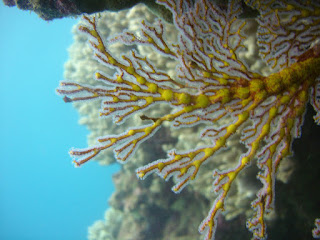 I've long held the view that some people, for their own protection, should have to wear a helmet full time.
I've long held the view that some people, for their own protection, should have to wear a helmet full time.Luckily, this guy had one on or he might have done much worse than a broken foot following his fall at Hammersley Gorge from the top of the photo into the pool at the bottom - roughly 30m.
The bottle of OP rum he'd drunk to celebrate ANZAC day might have made a difference too. It was pretty sickening, we both saw the fall from start to finish, bounce, bounce, splash. His 'mates' didn't seem too concerned and were in no rush to help. When we asked what first aid they had in their ute they said a case of cold beer.
We prudently made a fairly hasty exit once we'd made sure he'd not sustained any head injuries. His Australian safety boots hadn't provided any protection for his left foot which was already blue. Neither of us thought he'd be a particularly compliant patient.
 With all that excitement out of the way, we pushed on to the Rio Tinto Railway road and made our way up to Millstream Chichester National Park.
With all that excitement out of the way, we pushed on to the Rio Tinto Railway road and made our way up to Millstream Chichester National Park.The road is generally pretty well looked after, but there had been a recent derailment and lots of very heavy vehicles had been using it to make repairs. Outcome was the corrugations were pretty bad.
A couple of iron-ore laden trains came past us, and a few empty ones the other way. One of the drivers gave us a toot of his horn which I think is Ness's highlight of the whole trip since we left Sydney.


Millstream Chichester National Park is really two separate distinct parks. We stopped at Millstream for a couple of nights on the banks of the beautiful Fortescue River. The river had recently been in massive flood which had done a lot of damage to the park, with large sections still out of bounds, but the Crossing Pool campsite was in good nick and we secured primo real estate with the end spot.


There are apparently 170 types o
 f bird in the park. Our part of the park was dominated by noisy Corellas.
f bird in the park. Our part of the park was dominated by noisy Corellas. They provided us with constant amusement, particularly when they landed on or made their way along to a bit of branch too narrow for their claws to get sufficient purchase to hold them upright. Gravity took over, followed by much screeching and wing flapping to get right side up again. We witnessed some gymnastics of Olympic quality.




* reflections of the Fortescue, river crossing ahead, and payniac preparing some healthy bush tucker (beef and hopefully flu-free snags)


 This morning we reluctantly packed up and made our way through the Chichester part of the park, stopping for Ness to have a dip at the Python Pool.
This morning we reluctantly packed up and made our way through the Chichester part of the park, stopping for Ness to have a dip at the Python Pool.Lots more red dirt of course, and also Ness spotted some Desert Peas, although they probably weren't Sturt ones because they were missing their black centre.

 We're now in Dampier and will hug the coast, and mobile reception, this week as there is a bit going on the office (silly me had thought it was a long weekend in NSW but apparently the NSW government doesn't hold the same respect for ANZAC celebrations when the day proper falls on a weekend). Result being I'm in a spot of trouble for not doing what I'd promised I'd do over the weekend (no reception). So had better stop procrastinating and get on with it.
We're now in Dampier and will hug the coast, and mobile reception, this week as there is a bit going on the office (silly me had thought it was a long weekend in NSW but apparently the NSW government doesn't hold the same respect for ANZAC celebrations when the day proper falls on a weekend). Result being I'm in a spot of trouble for not doing what I'd promised I'd do over the weekend (no reception). So had better stop procrastinating and get on with it.Hope all are well, and please avoid Mexicans with running noses. If you have any spare Tamiflu please send it asap to me, care of Broome Post Office. We'll be there next Monday.





































